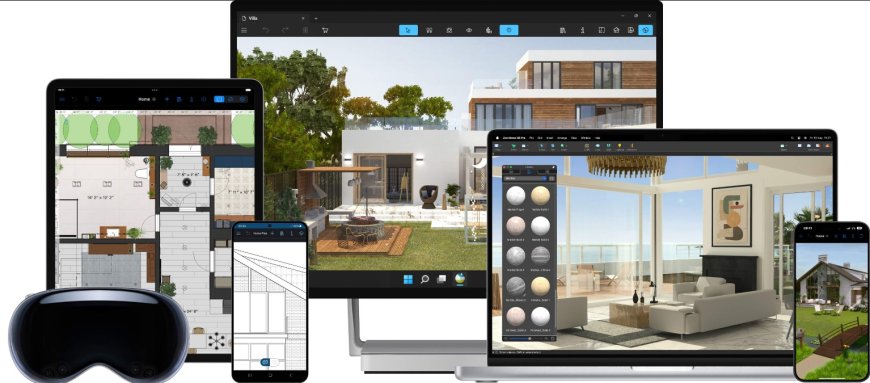Transforming Spaces: The Power of 3D Exterior and Interior Visualization

In today’s world of design and architecture, 3D visualization has become an essential tool that revolutionizes how we conceptualize and create spaces. Whether you're working on a residential project, a commercial development, or even a landscape design, 3D Exterior and Interior Visualization helps bring ideas to life, enabling clients and designers to see, adjust, and perfect spaces before they are built.
But what exactly is 3D visualization, and why is it such a game-changer in the design world? In this article, we’ll explore the power of 3D visualization, its benefits, and how it transforms both exterior and interior spaces into works of art.
Introduction
The world of architecture and interior design has experienced a digital transformation thanks to 3D visualization. This powerful tool allows designers, architects, and clients to experience a visual journey of their projects before a single brick is laid or wall is painted. From enhancing communication to creating more accurate design previews, 3D visualization is now indispensable in transforming spaces.
What is 3D Visualization?
The Basics of 3D Rendering
3D visualization is a process that creates three-dimensional images or animations that illustrate architectural or design concepts. It takes 2D plans or sketches and brings them into a 3D environment, giving viewers a full sense of scale, perspective, and spatial relationships. Through advanced rendering software, these designs become incredibly lifelike.
Differences Between 2D and 3D Visualization
Unlike traditional 2D drawings or blueprints, which provide a flat, sometimes abstract, view of a space, 3D visualization offers a more immersive, true-to-life experience. With 3D, you can see how light interacts with a space, how furniture fits within a room, and how exteriors look in different seasons—all with great precision.
Why 3D Visualization is Essential in Modern Design
Enhanced Communication with Clients
One of the biggest challenges in design is conveying ideas to clients who may struggle to interpret flat drawings or technical jargon. 3D visualization bridges that gap, offering clients a clear and detailed preview of the final product. It allows for better collaboration and ensures everyone is on the same page.
Accurate Project Previews
3D visualization doesn’t just show what a space will look like; it provides an accurate preview of its dimensions, proportions, and design elements. This precision reduces the risk of miscalculations, ensuring that the final construction matches the original concept.
3D Exterior Visualization
Bringing Outdoor Spaces to Life
With 3D exterior visualization, architects and landscape designers can show clients exactly how an outdoor space will look when completed. From the architectural design of a home’s exterior to landscape features like gardens, patios, and driveways, this tool makes it easy to see how all elements come together harmoniously.
Landscape and Urban Planning
3D visualization is incredibly useful for large-scale projects, such as urban planning or landscape architecture. It helps designers visualize how buildings, public spaces, and natural elements will interact, providing a more comprehensive understanding of the environment.
Realistic Lighting and Weather Effects
An impressive feature of 3D exterior visualization is the ability to simulate different lighting conditions and weather effects. This allows designers and clients to see how a building or outdoor space will look at various times of day or in different seasons, helping to make informed decisions about design choices.
3D Interior Visualization
Visualizing Interior Layouts
3D interior visualization allows designers to experiment with different room layouts, ensuring that furniture, fixtures, and pathways work well together. It provides a bird’s-eye view of the space while also allowing for more detailed walkthroughs of the environment.
Furniture and Decor Placement
Gone are the days of guessing whether that couch will fit in your living room. With 3D visualization, furniture and decor items can be placed virtually within the space, giving clients the opportunity to see how everything will look together before making any purchases.
Realistic Textures and Finishes
3D rendering software can simulate a wide variety of textures, materials, and finishes. This allows clients to see how different flooring types, wall colors, and fabrics will look within the space, making it easier to select design elements that complement each other.
Benefits of 3D Visualization for Designers
Efficient Design Process
By creating a visual representation of the space early in the design process, designers can quickly make adjustments, reducing the need for costly revisions later on. This efficiency is particularly important in large-scale projects where changes can be time-consuming and expensive.
Early Problem Detection
Since 3D visualization provides a comprehensive view of the space, potential design issues can be identified and addressed before construction begins. This proactive approach minimizes the risk of costly errors and delays.
Time and Cost Savings
By streamlining communication, reducing the need for physical prototypes, and enabling quicker decision-making, 3D visualization saves both time and money for designers and clients alike.
Impact on Client Decisions
Improved Decision-Making
With 3D visualization, clients can make informed decisions about design elements, from the overall layout to specific material choices. Seeing a realistic preview of the finished product helps clients feel more confident about their selections.
Reducing Misunderstandings
3D visualization helps to eliminate misunderstandings between designers and clients. Since clients can see a lifelike representation of the space, they are less likely to request changes later in the process, leading to smoother project execution.
Customization and Flexibility
Tailoring Designs to Individual Preferences
No two clients are the same, and 3D visualization allows for a high level of customization. Whether it's adjusting the layout of a room or changing the color scheme, this tool makes it easy to tailor the design to fit the client’s specific needs.
Testing Different Styles and Layouts
Before committing to a final design, clients can use 3D visualization to explore different styles, layouts, and configurations. This flexibility is key to ensuring that the final design aligns with the client’s vision.
Technologies Behind 3D Visualization
Software Tools for 3D Rendering
Advanced software tools such as AutoCAD, SketchUp, and 3ds Max are commonly used for 3D rendering in the design industry. These tools allow designers to create detailed and realistic representations of both exterior and interior spaces.
Integrating Virtual Reality (VR) and Augmented Reality (AR)
The next step in 3D visualization is integrating it with VR and AR. These immersive technologies enable clients to walk through virtual spaces and interact with designs in real-time, offering an even deeper understanding of the project before construction begins.
3D Visualization in Real Estate Marketing
Virtual Property Tours
For real estate professionals, 3D visualization is a powerful marketing tool. Virtual property tours allow potential buyers to explore a home from anywhere in the world, giving them a realistic sense of the space without needing to physically visit the property.
Boosting Sales with Immersive Experiences
Immersive 3D experiences make properties more attractive to buyers. By providing detailed and interactive visualizations, real estate agents can highlight key features and help clients envision themselves in the space.
Challenges of 3D Visualization
Potential Costs and Time Investment
While 3D visualization offers many benefits, it can also require a significant investment in time and money, especially for complex projects. However, the long-term savings often outweigh the initial costs.
Learning Curves for Software
The sophisticated software used for 3D rendering has a steep learning curve, and mastering it requires time and technical expertise. This can be a challenge for designers new to the field.
Sustainability and Green Building with 3D Visualization
Optimizing Space for Energy Efficiency
3D visualization plays a vital role in sustainable design by helping to optimize building layouts for energy efficiency. Designers can simulate different heating, cooling, and lighting systems to find the most eco-friendly solutions.
Material and Resource Planning
By visualizing the materials and resources required for a project, designers can make more sustainable choices, such as using locally sourced materials or minimizing waste during construction.
The Future of 3D Visualization in Design
Advancements in AI and Machine Learning
As AI and machine learning technologies evolve, they will further enhance 3D visualization. Designers will be able to automate certain aspects of the rendering process, making it faster and more accurate.
Increased Use of Immersive Technologies
The future of 3D visualization lies in the increased use of immersive technologies like VR and AR. As these tools become more accessible, they will continue to revolutionize how we design and experience spaces.
Case Studies: Successful 3D Visualization Projects
Residential Home Transformations
One notable example of successful 3D visualization is its use in residential home transformations. Designers can show clients exactly how a renovation or new build will look, resulting in fewer surprises and greater satisfaction with the finished product.
Commercial Spaces and Public Buildings
In commercial projects, 3D visualization has been instrumental in creating functional, aesthetically pleasing spaces. Whether it's a new office building or a public space like a park or library, 3D rendering helps ensure the design meets the needs of its users.
Conclusion: Elevating Design with 3D Visualization
3D visualization has transformed the world of design by allowing architects, interior designers, and clients to fully experience a space before it's built. With its ability to enhance communication, save time and costs, and deliver customized, accurate designs, it’s no wonder 3D visualization has become a go-to tool in the industry. Whether you're designing a home, a commercial building, or a landscape, 3D visualization will help bring your vision to life in the most realistic and impactful way.
FAQs
-
What is 3D visualization in design?
3D visualization is the process of creating three-dimensional images or animations that represent architectural or design concepts, offering a realistic preview of a space. -
How does 3D visualization benefit architects and designers?
It improves communication with clients, speeds up the design process, helps detect potential issues early on, and reduces the overall cost of revisions. -
Can 3D visualization be used for both interior and exterior design?
Yes, 3D visualization is widely used in both interior and exterior design, allowing for detailed representations of room layouts, furniture placement, landscaping, and more. -
What are the challenges of using 3D visualization?
The main challenges include the high cost of software, time investment, and the steep learning curve required to master the tools used for 3D rendering. -
How does 3D visualization impact real estate marketing?
3D visualization allows real estate professionals to create virtual property tours, making it easier to showcase homes and properties to potential buyers.
What's Your Reaction?




















